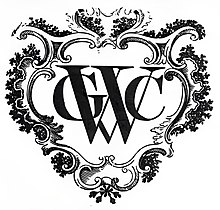Dutch West India Company
Dutch West India Company (Dutch: Westindische Compagnie) was a chartered company of Dutch merchants as well as foreign investors, formally known as GWC (Geoctrooieerde Westindische Compagnie; English: Chartered West India Company). Among its founders were Reynier Pauw, Willem Usselincx (1567–1647), and Jessé de Forest (1576–1624). On 3 June 1621, it was granted a charter for a trade monopoly in the Dutch West Indies by the Republic of the Seven United Netherlands and given jurisdiction over Dutch participation in the Atlantic slave trade, Brazil, the Caribbean, and North America.
Origins
changeThe West India House, headquarters of the Dutch West India Company from 1623 to 1647
Reinier Pauw, Portrait by Jan Anthonisz. van Ravesteyn
When the Dutch East India Company (VOC) was founded in 1602, some traders in Amsterdam disagreed with its monopolistic policies. With help from Petrus Plancius, a Dutch-Flemish astronomer, cartographer, and clergyman, they sought a northeastern or northwestern access to Asia to circumvent the VOC monopoly. In 1609, English explorer Henry Hudson, in employment of the VOC, landed on the coast of New England and sailed up what is now known as the Hudson River in his quest for the Northwest Passage to Asia. However, he failed to find a passage. Consequently, in 1615, Isaac Le Maire and Samuel Blommaert, assisted by others, focused on finding a south-westerly route around South America's Tierra del Fuego archipelago to circumvent the VOC monopoly.
Trade with the Caribbean, for salt, sugar, and tobacco, was hampered by Spain and delayed because of peace negotiations. Spain offered peace on condition that the Dutch Republic would withdraw from trading with Asia and America. Spain refused to sign the peace treaty if a West Indian Company would be established. At this time, the Dutch War of Independence (1568–1648) between Spain and the Dutch Republic was occurring. Grand Pensionary Johan van Oldenbarnevelt offered to suspend trade with the West Indies in exchange for the Twelve Years' Truce. He took the proposal of founding a West-India Company off the table. The result was that, during a few years, the Dutch sailed under a foreign flag to South America. However, ten years later, Stadtholder Maurice of Orange proposed to continue the war with Spain, but also to distract attention from Spain to the Republic. In 1619, his opponent Johan van Oldenbarnevelt was beheaded, and when in April 1621 the truce expired, the West Indian Company could be established.
Involvement in Brazil
changeFrom 1624 to 1654, in the context of the Dutch–Portuguese War, the GWC held Portuguese territory in northeast Brazil, but they were ousted from Dutch Brazil following fierce resistance. After several reversals, the GWC reorganized and a new charter was granted in 1675, largely on the strength of the Atlantic slave trade. This "new" version lasted for more than a century, until after the Fourth Anglo–Dutch War, during which it lost most of its assets.[1]
Decline
changeThe decline of the Dutch West India Company was marked by financial difficulties, loss of territory, and decreased influence in the Americas, culminating in its eventual dissolution.[2]
Restart
changeAfter the initial decline, attempts were made to revitalize the company, but it never regained its former prominence.[3][4]
Second West India Company
changeA second iteration of the West India Company was established, but it faced similar challenges and was ultimately unable to establish a lasting presence.
See also
change- Dutch East India Company
- History of the Netherlands
- Atlantic slave trade
Notes
change- ↑ Broecke, Pieter van den (2000). Pieter Van Den Broecke's Journal of Voyages to Cape Verde, Guinea and Angola, 1605-1612. Hakluyt Society. ISBN 978-0-904180-68-8.
- ↑ Adams, Julia (2005). The Familial State: Ruling Families and Merchant Capitalism in Early Modern Europe. Cornell University Press. ISBN 978-0-8014-7404-0.
- ↑ "1.05.02 Inventaris van het archief van de Directie ad Interim, [1791-1792]; Raad der Koloniën, [1792-1795], (1773) 1791-1795 (1796) | Nationaal Archief". www.nationaalarchief.nl (in Dutch). Retrieved 2024-10-07.
- ↑ "About this Collection | World Digital Library | Digital Collections | Library of Congress". Library of Congress, Washington, D.C. 20540 USA. Retrieved 2024-10-07.
References
change- Author, A. (Year). Title of the Source. Publisher.
- Author, B. (Year). Title of the Source. Publisher.
Further reading
change- Author, C. (Year). Title of the Source. Publisher.
